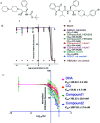Multistage antiplasmodial activity of hydroxyethylamine compounds, in vitro and in vivo evaluations
- PMID: 35686031
- PMCID: PMC9127639
- DOI: 10.1039/d0ra03997g
Multistage antiplasmodial activity of hydroxyethylamine compounds, in vitro and in vivo evaluations
Abstract
Malaria, a global threat to the human population, remains a challenge partly due to the fast-growing drug-resistant strains of Plasmodium species. New therapeutics acting against the pathogenic asexual and sexual stages, including liver-stage malarial infection, have now attained more attention in achieving malaria eradication efforts. In this paper, two previously identified potent antiplasmodial hydroxyethylamine (HEA) compounds were investigated for their activity against the malaria parasite's multiple life stages. The compounds exhibited notable activity against the artemisinin-resistant strain of P. falciparum blood-stage culture with 50% inhibitory concentrations (IC50) in the low micromolar range. The compounds' cytotoxicity on HEK293, HepG2 and Huh-7 cells exhibited selective killing activity with IC50 values > 170 μM. The in vivo efficacy was studied in mice infected with P. berghei NK65, which showed a significant reduction in the blood parasite load. Notably, the compounds were active against liver-stage infection, mainly compound 1 with an IC50 value of 1.89 μM. Mice infected with P. berghei sporozoites treated with compound 1 at 50 mg kg-1 dose had markedly reduced liver stage infection. Moreover, both compounds prevented ookinete maturation and affected the developmental progression of gametocytes. Further, systematic in silico studies suggested both the compounds have a high affinity towards plasmepsin II with favorable pharmacological properties. Overall, the findings demonstrated that HEA and piperidine possessing compounds have immense potential in treating malarial infection by acting as multistage inhibitors.
This journal is © The Royal Society of Chemistry.
Conflict of interest statement
There are no conflicts to declare.
Figures









Similar articles
-
The Multistage Antimalarial Compound Calxinin Perturbates P. falciparum Ca2+ Homeostasis by Targeting a Unique Ion Channel.Pharmaceutics. 2022 Jun 28;14(7):1371. doi: 10.3390/pharmaceutics14071371. Pharmaceutics. 2022. PMID: 35890267 Free PMC article.
-
Fast-Acting Small Molecules Targeting Malarial Aspartyl Proteases, Plasmepsins, Inhibit Malaria Infection at Multiple Life Stages.ACS Infect Dis. 2019 Feb 8;5(2):184-198. doi: 10.1021/acsinfecdis.8b00197. Epub 2019 Jan 2. ACS Infect Dis. 2019. PMID: 30554511
-
Novel halogenated arylvinyl-1,2,4 trioxanes as potent antiplasmodial as well as anticancer agents: Synthesis, bioevaluation, structure-activity relationship and in-silico studies.Eur J Med Chem. 2021 Nov 15;224:113685. doi: 10.1016/j.ejmech.2021.113685. Epub 2021 Jul 10. Eur J Med Chem. 2021. PMID: 34303874
-
Small Molecules Effective Against Liver and Blood Stage Malarial Infection.Curr Top Med Chem. 2019;18(23):2008-2021. doi: 10.2174/1568026619666181129143623. Curr Top Med Chem. 2019. PMID: 30499395 Review.
-
Multistage inhibitors of the malaria parasite: Emerging hope for chemoprotection and malaria eradication.Med Res Rev. 2018 Sep;38(5):1511-1535. doi: 10.1002/med.21486. Epub 2018 Jan 26. Med Res Rev. 2018. PMID: 29372568 Review.
Cited by
-
Antiviral evaluation of hydroxyethylamine analogs: Inhibitors of SARS-CoV-2 main protease (3CLpro), a virtual screening and simulation approach.Bioorg Med Chem. 2021 Oct 1;47:116393. doi: 10.1016/j.bmc.2021.116393. Epub 2021 Sep 4. Bioorg Med Chem. 2021. PMID: 34509862 Free PMC article.
-
The Multistage Antimalarial Compound Calxinin Perturbates P. falciparum Ca2+ Homeostasis by Targeting a Unique Ion Channel.Pharmaceutics. 2022 Jun 28;14(7):1371. doi: 10.3390/pharmaceutics14071371. Pharmaceutics. 2022. PMID: 35890267 Free PMC article.
References
-
- WHO, World malaria report, World Health Organization, Geneva, 2019
LinkOut - more resources
Full Text Sources

